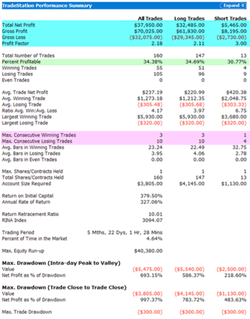A systems developer describes the discipline and commitment required to select a proper system and trade for success and longevity using mechanical methods.
By Donald Pendergast
Plenty of traders are beginning to appreciate the benefits of a mechanical, completely objective style of trading, and that’s a good thing. After enduring years of needless losses caused by jumping from one advisory service to another (sometimes in the midst of a normal drawdown), these traders now want to immerse themselves in the highly disciplined, relatively emotionless world of systems trading. That’s wonderful, but there can be (and usually is) a large gap separating the initial intellectual embrace of a sound concept or belief system and the actual, day-to-day regimen of actually conforming one’s life (or trading activities) in accordance with such a discipline. Here’s a look at one reason why, especially as it pertains to system trader hopefuls.
System Suitability
In the graphic below, you’ll notice that the statistics for this particular hypothetical silver futures trading system appear to be very impressive. Even if the system made half of what these backtested results show, some traders would still likely consider trading it… until it begins a losing streak; one that is clearly shown to be possible (and highly probable) in the backtest results.
Imagine losing on ten trades in a row! Really, would you have enough psychological fortitude to serenely ride out such a streak of losses, hopeful that the system would eventually go on to make new equity highs?
Or, maybe after five or six losing trades (ouch!), would you instead start surfing the Web for the opinions and commentary of the “silver gurus,” looking for some assurance that you should continue to hold or even abandon your current silver system position? Even worse, such an unstable trader might even be tempted to abandon the system, probably at the point of maximum pain and drawdown just before the system takes off on a long winning streak. If you do those kinds of self-destructive things more than a few times, you’re definitely not a good fit for a systems trading lifestyle, since such behavior exemplifies a complete lack of faith (unbelief) in the tested logic of the system. If you don’t have absolute faith in your system, you won’t be able to trade it long enough to enjoy the fruit of long-term profits that such a system can hopefully offer.
NEXT: How to Build Confidence for the Long Haul
|pagebreak|System Diversity
One interesting way of encouraging a trader to stick with an otherwise sound trading system for the long haul is to combine the system with two or even three other non-correlated systems, with the goal being to help minimize drawdowns and periods of extreme psychological stress. In theory, especially if these additional systems each focus on a market from a specific commodity sector, this kind of portfolio management can help make sure that each system’s strengths will be able to help pull the system trader’s equity curve to new highs and with smaller drawdown.
In a perfect world, that’s the goal you strive for, but even here, you’re still going to need to tough out some drawdowns, keep on top of the systems to refine as needed, roll contracts at the right time, and so forth. It’s not exactly a day at the beach; relying on your systems (or even having others trade them for you) despite all of those futures broker ads depicting smiling golfers, skiers, boaters, and world travelers with the implication being that their brokers and/or systems are raking in piles of cash for them, helping them maintain their exceptionally opulent, highly mobile, and care-free lifestyles.
Get real! Even if you’re independently wealthy with $10 million in a futures margin account and lots of free time for travel, charitable work, and family and friends, you are still going to have to maintain the same level of commitment to systems trading as the small-fry market participant with a $25,000 account who trades a couple of e-mini Russell contracts every day. There’s no escaping that fact, even if someone else trades your account for you. And the only way to develop that kind of commitment is to study, know, and then believe in the backward and forward test stats for the systems you want to trade.
The hypothetical silver system shown above might then be traded along with a swing trading system for crude oil futures, a seasonal-based system for corn and wheat futures, and an intraday e-mini stock index futures system. Obviously, you’d need to implement some fancy portfolio system testing procedures to determine the optimum mix for your own particular risk/reward profile and financial goals, but the end result might be well worth the effort.
Faith and Commitment
So, whether you decide to trade a single system or an entire portfolio of systems, one fact is clear: You’re going to have to believe in your systems fully so that you can take every trade and then endure every drawdown on the pathway to a steadily rising equity line for your account. The best way to build up your faith is to do extensive backtesting and forward testing for every system you intend to use, taking into account your own psychological strengths and weaknesses as you do so. As in most things in life, those who are committed to a successful outcome (and who are able and willing to do what is necessary to achieve success) in a given venture are the ones most likely to enjoy the fruits of victory. How committed are you when it comes to trading a fully automated, completely objective trading system?
By Donald Pendergast
Donald W. Pendergast Jr. is founder of Linear Trading Systems LLC. Linear Trading Systems LLC develops and markets mechanical, fully automated trading systems, currently offering various systems on a subscription basis at Striker Securities, Inc. and also at Collective2, two of the premier systems trading venues today. Contact Donald using the information below:
E-mail: linearjax@gmail.comWeb: www.linearjax.com
Phone: 904-596-9362






















